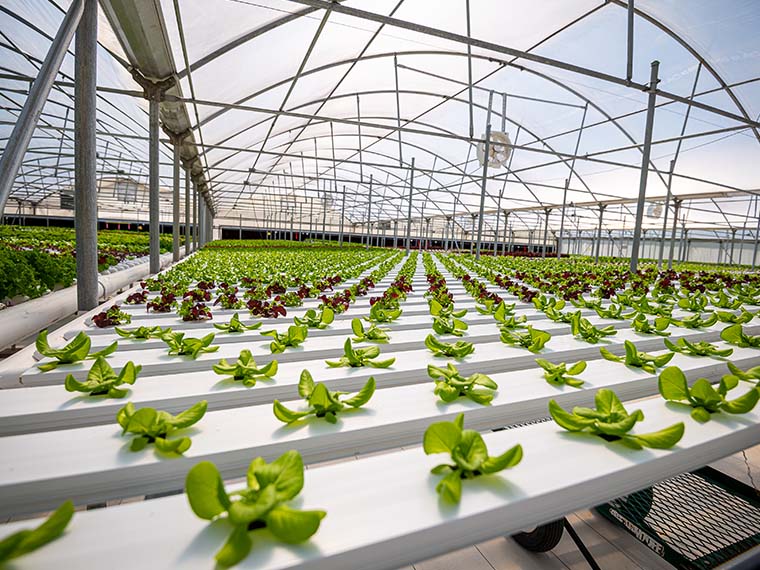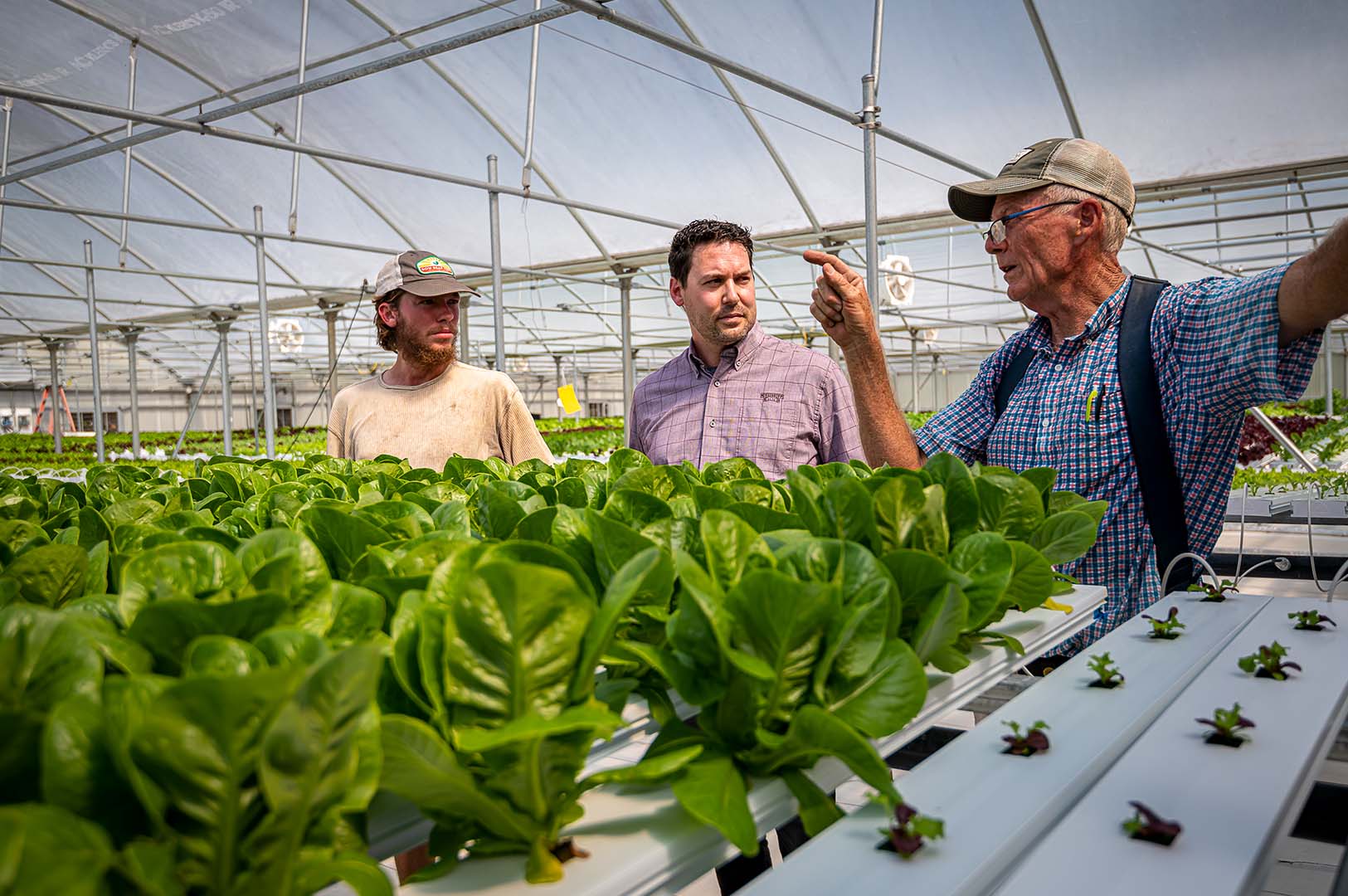The information presented on this page may be dated. It may refer to situations which have changed or people who are no longer affiliated with the university. It is archived as part of Mississippi State University's history.
ON THE WEST COAST, lettuce fields paint the scenery surrounding many central cities. Beyond the urban sprawl, rows of lettuce dot the landscape for what seems like miles, looking like an ocean of leafy green. With more than 200,000 acres of lettuce fields in the state of California alone, production of this salad staple is often overlooked in other states.
And while California and Arizona produce 98 percent of leaf lettuce in the U.S., many states, including Mississippi, produce the vegetable for local consumption. That is why scientists in the Mississippi Agricultural and Forestry Experiment Station recently partnered with a Mississippi produce grower to help improve yields.
Just 25 miles outside of Mississippi's capital city lies a bounty of produce. Instead of acres of lettuce, the picture-perfect leafy greens grow across 18,000 square feet of six bay greenhouses. The Flora, Mississippi-based operation is not only the heart of produce that provides the crop to many local restaurants but also serves the entire state.
Salad Days, LLC, a greenhouse hydroponics salad producer, noticed a decrease in yields during winter months. The farm reached out to Dr. Casey Barickman, associate research professor in plant and soil sciences at the MAFES North Mississippi Research and Extension Center in Verona.
Hydroponics is a method that skips the soil. Crops are grown in nutrient-rich water, exposing the roots directly to the nutritious solution. Barickman set out to see if manipulating the electroconductivity-or concentration of mineral elements-of the nutrient solutions during each season would increase lettuce yields.
"The purpose of this research is to determine how increasing levels of electroconductivity, yearly seasonal changes, and differences in lettuce varieties affected yield, biomass accumulation, and polyphenol concentrations, which are antioxidants found in plant-based foods," Barickman explained.
He said the idea for the research came after conducting projects with his graduate student.
"Our research came from an idea I had when talking with Salad Days, LLC about their yield being sluggish during the winter," Barickman said. "Will Sublett, my graduate student at the time, and I decided to conduct a few research projects related to increasing lettuce yields by modifying the electroconductivity, or EC, of the nutrient solutions during each season."
The scientists used green and red-leaf cultivars and grew them in a deep-water culture production system-a hydroponic method that suspends plant roots in a nutrient-rich solution-in a greenhouse for 21 days before they were transplanted. The experiment also consisted of three nutrient treatments of different electroconductivity levels. Plants were harvested, processed, and analyzed after 50 days to determine biomass, marketable yield, plant height, stem diameter, phenolics, and elemental nutrient concentrations. The study found that the effects of growing season, in this case, temperature and sunlight, and cultivar were more evident on yield and quality than that of the EC nutrient solution treatment. However, scientists also found that the optimal solution for Southeastern producers is to change the nutrient solution concentration as the seasons change.
With the results garnered from the study, Barickman was hopeful altering EC levels in the nutrient solution would lead to better yield for Salad Days, LLC. While greenhouses can regulate temperature and moisture to some extent to allow for a year-round growing season, much still depends on external temperature and light. Barickman and the Salad Days, LLC team changed the electroconductivity of their hydroponic solution to combat the changes in temperature and moisture that come with the seasons.
"Specifically, in the spring and winter, growers will want to increase their EC so that the lettuce plants have access to available nutrients during periods of cold, cloudy weather," Barickman said. "In the summer, when sunshine and hot days are abundant, lettuce plants use more water. So, lowering the EC will prevent the plants from having abundant nutrients in the roots and leaf tissue, which can cause the tissues to burn or become severely damaged."
Barickman's suggested changes were implemented by Salad Days, LLC and returned a 70 percent increase in yields and a 40 percent increase in profits in a single year.
Barickman, a plant physiologist with 15 years of experience in hydroponics, says that while there are benefits to growing lettuce in a hydroponic greenhouse environment, challenges can also arise that might negatively impact yield.
"When you place hydroponic systems into greenhouses, the challenges increase because a producer is trying to control the greenhouse environment while battling weather conditions," Barickman said. "Challenges associated with growing hydroponically in a greenhouse for the southern US are hot temperatures, humidity, fluctuations in temperature, low light conditions in the winter, and high nighttime temperatures in the summer."
Jamie Redmond, owner of Salad Days, LLC, said the need for changes came when water tests showed a loss of nutrients in their solution.
"We began to see through water tests that we were losing nitrogen and potassium pretty quickly, so we had to continue testing to find out when the levels needed correcting," Redmond said.
He said the changes suggested by MAFES researchers significantly increased the production yield and crop quality.
"We ended up with a record output for what is usually the worst time of the year," Redmond said. "Winter, with its short and usually cloudy days, is not the greenhouse grower's friend. We do not have supplemental lighting in our building, so you can imagine how happy we were with the changes we made and thankful for Dr. Barickman's research and help."
Barickman has been working with Salad Days, LLC for numerous years. Redmond adds that he is pleased with Barickman's work and partnership.
"Dr. Barickman looked, listened, and was hands-on in our greenhouse, and he has experience with the Nutrient Film Technique, or NFT, system we are running," Redmond said. "He is very easy to work with, and we are lucky that he is in Mississippi. MSU has a great team with specialists in many areas and they are all accessible to local farmers."
"The Effect of Environment and Nutrients on Hydroponic Lettuce Yield, Quality, and Phytonutrient," which was awarded the best paper for 2020 in Horticulturae journal.
This research is based on work that is supported by the USDA-NIFA Hatch Project under accession number 149210. This research is funded by the Mississippi Agricultural and Forestry Experiment Station
When you place hydroponic systems into greenhouses, the challenges increase because a producer is trying to control the greenhouse environment while battling weather conditions.
Dr. Casey Barickman


